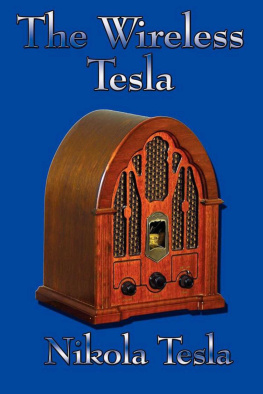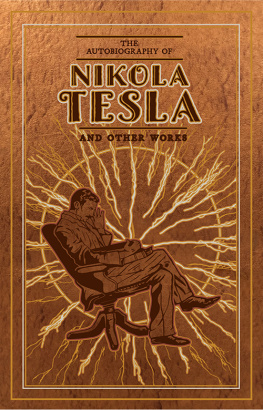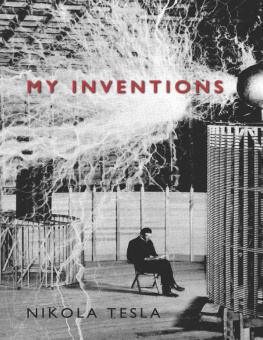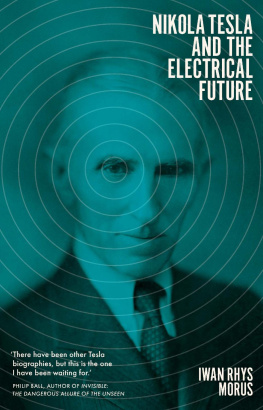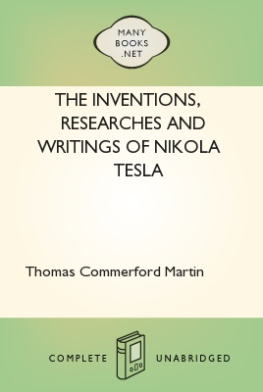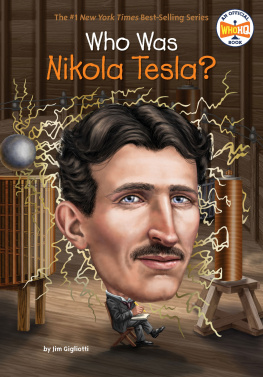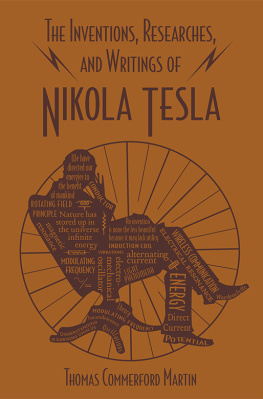Nikola Tesla - The Wireless Tesla
Here you can read online Nikola Tesla - The Wireless Tesla full text of the book (entire story) in english for free. Download pdf and epub, get meaning, cover and reviews about this ebook. year: 2013, publisher: Start Publishing LLC, genre: Romance novel. Description of the work, (preface) as well as reviews are available. Best literature library LitArk.com created for fans of good reading and offers a wide selection of genres:
Romance novel
Science fiction
Adventure
Detective
Science
History
Home and family
Prose
Art
Politics
Computer
Non-fiction
Religion
Business
Children
Humor
Choose a favorite category and find really read worthwhile books. Enjoy immersion in the world of imagination, feel the emotions of the characters or learn something new for yourself, make an fascinating discovery.
- Book:The Wireless Tesla
- Author:
- Publisher:Start Publishing LLC
- Genre:
- Year:2013
- Rating:3 / 5
- Favourites:Add to favourites
- Your mark:
- 60
- 1
- 2
- 3
- 4
- 5
The Wireless Tesla: summary, description and annotation
We offer to read an annotation, description, summary or preface (depends on what the author of the book "The Wireless Tesla" wrote himself). If you haven't found the necessary information about the book — write in the comments, we will try to find it.
The Wireless Tesla — read online for free the complete book (whole text) full work
Below is the text of the book, divided by pages. System saving the place of the last page read, allows you to conveniently read the book "The Wireless Tesla" online for free, without having to search again every time where you left off. Put a bookmark, and you can go to the page where you finished reading at any time.
Font size:
Interval:
Bookmark:
Scientific AmericanFeb. 2, 1901
Nikola Tesla has given to The New York Sun an authorized statement concerning his new experiments on the production of light without the aid of wires. Mr. Tesla says:
This light is the result of continuous efforts since my early experimental demonstrations before scientific societies here and abroad. In order to make it suitable for commercial use, I had to overcome great difficulties. One of these was to produce from ordinary currents of supply electrical oscillations of enormous rapidity in a simple and economical manner. This, I am glad to say, I have now accomplished, and the results show that with this new form of light a higher economy is practicable than with the present illuminants. The light offers, besides, many specific advantages, not the least of which is found in its hygienic properties. It is, I believe, the closest approach to daylight which has yet been reached from any artificial source.
The lamps are glass tubes which may be bent in any ornamental way. I most generally use a rectangular spiral, containing about twenty to twenty-five feet of tubing making some twelve to fourteen convolutions. The total illuminating surface of a lamp is from 300 to 400 square inches. The ends of the spiral tube are covered with a metallic coating, and provided with hooks for hanging the lamp on the terminals of the source of oscillations. The tube contains gases rarefied to a certain degree, determined in the course of long experimentation as being conductive to the best results.
The process of light production is, according to my views, as follows: The street current is passed through a machine which is an electrical oscillator of peculiar construction and transforms the supply current, be it direct or alternating, into electrical oscillations of very high frequency. These oscillations, coming to the metallically-coated ends of the glass tube, produce in the interior corresponding electrical oscillations, which set the molecules and atoms of the inclosed rarefied gases into violent commotion, causing them to vibrate at enormous rates and emit those radiations which we know as light. The gases are not rendered incandescent in the ordinary sense, for if it were so, they would be hot, like an incandescent filament. As a matter of fact, there is very little heat noticeable, which speaks well for the economy of the light, since all heat would be loss.
This high economy results chiefly from three causes: First, from the high rate of the electrical oscillations; second, from the fact that the entire light-giving body, being a highly attenuated gas, is exposed and can throw out its radiations unimpeded, and, third, because of the smallness of the particles composing the light-giving body, in consequence of which they can be quickly thrown into a high rate of vibration, so that comparatively little energy is lost in the lower or heat vibrations. An important practical advantage is that the lamps need not be renewed like the ordinary ones, as there is nothing in them to consume. Some of these lamps I have had for years, and they are now in just as good a condition as they ever were. The illuminating power of each of these lamps is, measured by the photometric method, about fifty candle power, but I can make them of any power desired, up to that of several arc lights. It is a remarkable feature of the light that during the day it can scarcely be seen, whereas at night the whole room is brilliantly illuminated. When the eye becomes used to the light of these tubes, an ordinary incandescent lamp or gas burner produces a violent pain in the eye when it is turned on, showing in a striking manner to what a degree these concentrated sources of light which we now use are detrimental to the eye.
I have found that in almost all its actions the light produces the same effects as-sunlight, and this makes me hopeful that its introduction into dwellings will have the effect of improving, in a measure now impossible to estimate, the hygienic conditions. Since sunlight is a very powerful curative agent, and since this light makes it possible to have sunlight, so to speak, of any desired intensity, day and night in our homes, it stands to reason that the development of germs will be checked and many diseases, as consumption, for instance, successfully combated by continually exposing the patients to the rays of these lamps. I have ascertained unmistakably that the light produces a soothing action on the nerves, which I attribute to the effect which it has upon the retina of the eye. It also improves vision just exactly as the sunlight, and it ozonizes slightly the atmosphere. These effects can be regulated at will. For instance, in hospitals, where such a light is of paramount importance, lamps may be designed which will produce just that quality of ozone which the physician may desire for the purification of the atmosphere, or if necessary, the ozone production can be stopped altogether.
The lamps are very cheap to manufacture, and by the fact that they need not be exchanged like ordinary lamps or burners they are rendered still less expensive. The chief consideration is, of course, in commercial introduction, the energy consumption. While I am not yet prepared to give exact figures, I can say that, given a certain quantity of electrical energy from the mains, I can produce more light than can be produced by the ordinary methods. In introducing this system of lighting my transformer, or oscillator, will be usually located at some convenient place in the basement, and from there the transformed currents will be led as usual through the building. The lamps can be run with one wire alone, as I have shown in my early demonstrations, and in some cases I can dispense entirely with the wires. I hope that ultimately we shall get to this ideal form of illumination, and that we shall have in our rooms lamps which will be set aglow no matter where they are placed, just as an object is heated by heat rays emanating from a stove. The lamps will then be handled like kerosene lamps, with this difference, however, that the energy will be conveyed through space. The ultimate perfection of apparatus for the production of electrical oscillations will probably bring us to this great realization, and then we shall finally have the light without heat or cold light. I have no difficulty now to illuminate the room with such wireless lamps, but a number of improvements must be made yet before it can be generally introduced.
Electrical World and Engineer, March 5, 1904
It is impossible to resist your courteous request extended on an occasion of such moment in the life of your journal. Your letter has vivified the memory of our beginning friendship, of the first imperfect attempts and undeserved successes, of kindnesses and misunderstandings. It has brought painfully to my mind the greatness of early expectations, the quick flight of time, and alas! the smallness of realizations. The following lines which, but for your initiative, might not have been given to the world for a long time yet, are an offering in the friendly spirit of old, and my best wishes for your future success accompany them.
Towards the close of 1898 a systematic research, carried on for a number of years with the object of perfecting a method of transmission of electrical energy through the natural medium, led me to recognize three important necessities: First, to develop a transmitter of great power; second, to perfect means for individualizing and isolating the energy transmitted; and, third, to ascertain the laws of propagation of currents through the earth and the atmosphere. Various reasons, not the least of which was the help proffered by my friend Leonard E. Curtis and the Colorado Springs Electric Company, determined me to select for my experimental investigations the large plateau, two thousand meters above sea-level, in the vicinity of that delightful resort, which I reached late in May, 1899. I had not been there but a few days when I congratulated myself on the happy choice and I began the task, for which I had long trained myself, with a grateful sense and full of inspiring hope. The perfect purity of the air, the unequaled beauty of the sky, the imposing sight of a high mountain range, the quiet and restfulness of the placeall around contributed to make the conditions for scientific observations ideal. To this was added the exhilarating influence of a glorious climate and a singular sharpening of the senses. In those regions the organs undergo perceptible physical changes. The eyes assume an extraordinary limpidity, improving vision; the ears dry out and become more susceptible to sound. Objects can be clearly distinguished there at distances such that I prefer to have them told by someone else, and I have heardthis I can venture to vouch forthe claps of thunder seven and eight hundred kilometers away. I might have done better still, had it not been tedious to wait for the sounds to arrive, in definite intervals, as heralded precisely by an electrical indicating apparatusnearly an hour before.
Font size:
Interval:
Bookmark:
Similar books «The Wireless Tesla»
Look at similar books to The Wireless Tesla. We have selected literature similar in name and meaning in the hope of providing readers with more options to find new, interesting, not yet read works.
Discussion, reviews of the book The Wireless Tesla and just readers' own opinions. Leave your comments, write what you think about the work, its meaning or the main characters. Specify what exactly you liked and what you didn't like, and why you think so.

